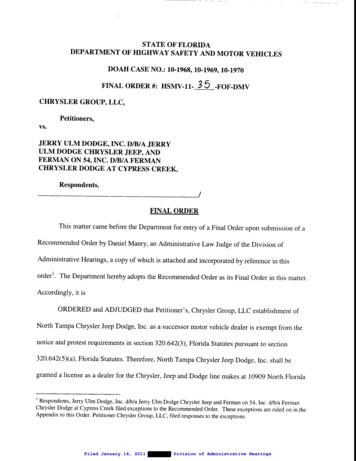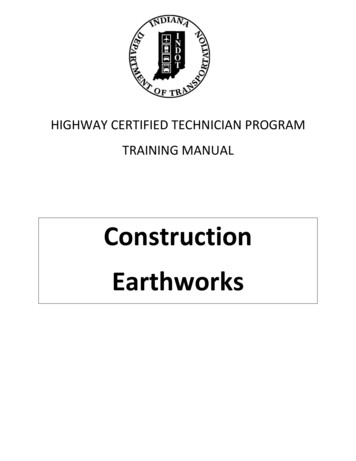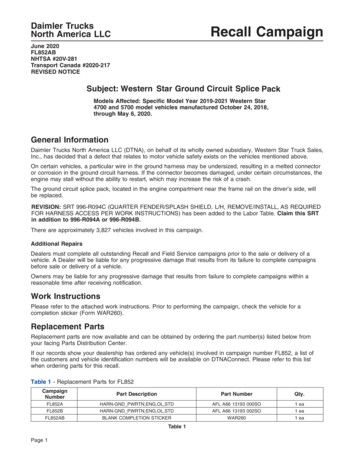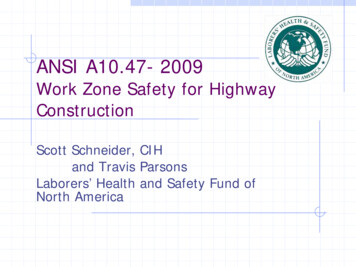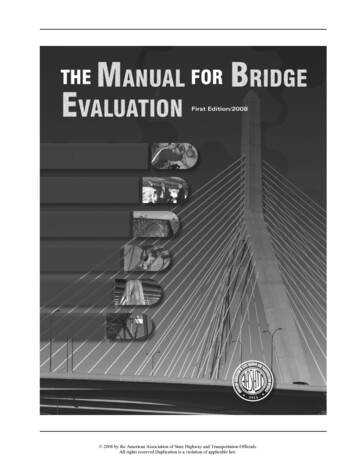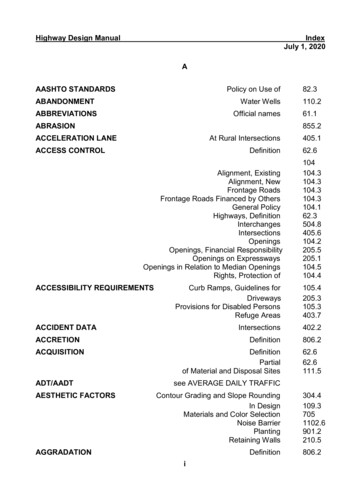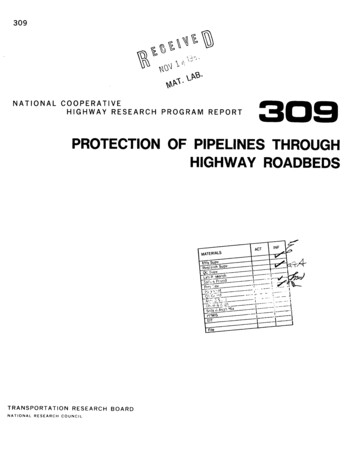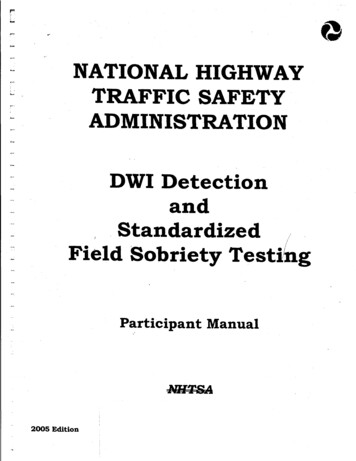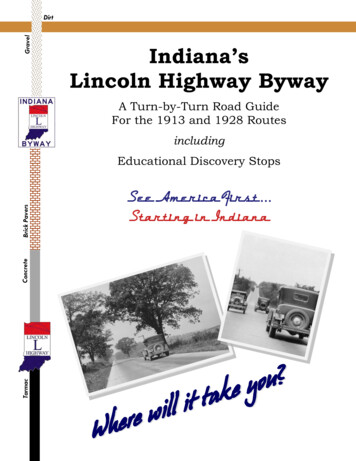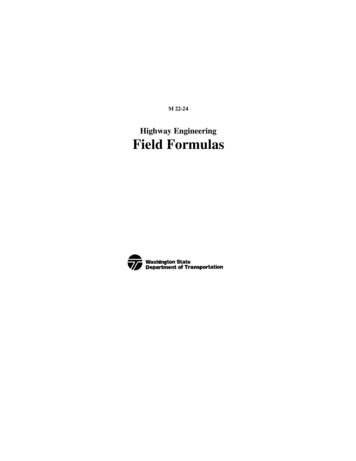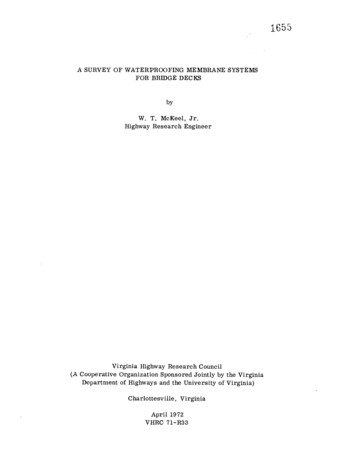
Transcription
A SURVEY OF WATERPROOFING MEMBRANEFOR BRIDGE DECKSSYSTEMSbyW. T. McKeel, Jr.Highway Research EngineerVirginia Highway Research Council(A Cooperative Organization Sponsored Jointly by the VirginiaDepartment of Highways and the University of Virginia)Charlottesville, VirginiaApril19 72VHRC 71-R33
A SURVEY OF WATERPROOFING MEMBRANEFOR BRIDGE DECKSSYSTEMSbyW. To McKeel, Jr.HighwayThe eckthe weakening of the surface over thepresents a serious maintenance problem. The needed repairsare often extensive and difficult; and, if the problem is ignored, the distress canbecome severe enough to necessitate replacement of the deck. The basic cause ofspalling is corrosion of the reinforcement in the presence of water and salt in ionicform, which has gained access either through cracks or by migration through the poresof the concrete. (I, 2) Many precautions can be taken in the design and construction ofa bridge to alleviate spalling; one of these, the subject of this paper, is the applicationof a waterproof membrane to the surface of the deck to prevent the entry of waterand salt solution into the concrete. At present, membranes are often placed on distressed bridge decks when repairs are made, but there is growing evidence to suggestthat the membrane is much more effective when applied before the deck is exposedtoofaconcretedeicing salts.The widespread interest in finding an effective means of protecting bridgedecks is evidenced by the initiation of a National Cooperative Highway Research Programproject, "Waterproof Membranes for Protection of Concrete Bridge Decks", inAugust 1970. The objective of the research is to develop or discover one or moreeffective waterproofing systems. Phase I of the project, which is scheduled forcompletion in October 1972, includes the development of service requirements, fieldinspections, and a program of laboratory studies. (3) While the researchers originallyconsidered about 140 materials, all but approximately 75 were eliminated before testingin the laboratory. Approximately 15 membranes of various materials were examinedin the field at about 50 sites. Although the final analysis of the data is just beginningat this writing, the principal researcher believes that some currently availablecommercial materials, possibly with slight modifications, will meet the requirementsof Phase I of the study. It is envisioned that perhaps 4 to 7 materials will be foundsuitable, and these will be field tested in Phase II, which is yet to be started.This paper will not concern itself with 75 membrane sealing systems. Instead,it will concentrate on fewer systems and attempt to introduce the judgments of varioushighway agencies on the performance of the systems. Highway engineers familiarwith the materials were contacted personally, and their cooperation is greatly
appreciated,systems NCHR1sealing as there is little in the way of written reports covering the newerThe comments of these individuals tend to reinforce the opinion of theresearchers that there are available materials which promise success inconcretebridge decks.GENERAL INFORMATIONA membrane seal is defined as a waterproof barrier placed on the surface ofbridgedeck as opposed to a penetrating sealer that enters the pores of the concrete.aIn general a membrane requires a hot asphaltic concrete wearing course, 1½ to2 inches thick, to protect it from traffic Exceptions are thick epoxy mortar overlays,which can serve as both a seal and a wearing surface, and possibly some urethanematerials, which the manufacturers claim do not require protective overlays undernormal traffic conditions. (2)The service requirements of a bridge deck overlay were listed in a recent articleby members of the Bridge Department of the California Division of Highways. (2)The requirements which are quoted below, are applicable regardless of the typeof membrane system used although the lower temperature limit, 0 F may bequestioned by some northern states.io2o3o4.It must bond to the concrete deck at least as well asan asphalt concrete blanket It must remain flexible throughout the entire range of decktemperatures which means down to at least 0 deg F.It must remain stable throughout the higher range oftemperatures up to 120 deg FoIt must be i00 percent effective as a moisturebarrier 5.It must be capable of bridging cracks up to 1/16 inowithout rupturing or losing its bond with therete deck It must be resistant toconc6.7owear or be capable of havingasphaltic concreteoverlaybonded to it to proanvide a waterproof system It must be chemically inert to oil salt, andthe usual highway liquids
MULTILAYEREDBITUMINOUS SYSTEMSThe most widely accepted membrane for sealing bridge decks is probably amultilayeredSuchor interlayer-- system such as that shown in Figure 1.systems using 3 to 5 applications of either coal tar emulsion slurry or roofingasphalt with 2 layers of coated glass fabric, are used on all important bridges inMain New Hampshire, Massachusetts, and Rhode Island, and on selected bridgesin Tennessee, Ohio, Michigan Illinois and Californiao (1) A membrane composedof 3 layers of fabric and 4 coats of asphalt is described in the Virginia specifications.(4)The Koppers Company has been active in the development of a similar membraneusing a plasticized coal tar.California uses as one of its standards, an interlayer system like thatdepicted in Figure 1, which is composed of 5 coats of coal tar emulsion applied ata rate of not less than 1/8 gallon per square yard and 2 plies of coal tar coated glassfabric (2) Experience there indicates that a membrane placed during the summeris much more effective than one placed during the fallomembrane utilizing 3 heavy coats (1o 08 gallons per square yard)been used quite successfully by New Hampshire They reportno deck distress in 20 years of routine application of the membrane at the time ofconstruction The roofing asphalt is specified because the highway agency believesthe coal tar emulsion to be too brittle at low temperatures Steep-pitch roofingasphalt, which melts at 200 F must be used to prevent slipping of the overlay duringhot weather. The glass fabric strips are placed on the first and second coats ofasphalt and the strips are lapped by slightly more than one half of their width A 2-inch asphalt concrete wearing course is placed on the membrane.ofAn interlayerroofing asphalt hasThe deficiencies associated with the interlayer membranes are largelyassociated with the time consuming and rather difficult technique of application.The difficulties in handling the materials are solved in New Hampshire by employingskilled roofing contractors to apply the membrane. The time delay is inescapable;each coat of the asphalt or coal tar must be allowed to dry before the next layerother than the glass fabricis applied Thus the application of the complete membranesystem will require more than a day's time. New Hampshire is investigating thesuitability of other membrane systems, not becuase of dissatisfaction with theeffectiveness of their standard membrane but as a means of saving time and laborcosts Difficulties may be encountered in the case of the interlayer membrane andmost others except epoxies when the asphaltic concrete wearing course is placed.Protrusions or foreign matter on the deck surface can puncture the membrane duringpassage of the paving machine. California reports that the effectiveness of theapparently perfect waterproof seal has been known to drop as much as 30 percentafter placement of the wearing course (2)
., . Asphalt Wearing SurfoBituminousBond CootCoal Tar Emulsion0x v e raySlurry Fiberglass FabricCool Tar Emulsionx'X - - MWaterproofFiberglass FabricCoole nTar Emulsion o e Cool Tar Emulsion Penetrating Primer'N Cleon Concrete SurfaceFigure 1.typical interlayer(From reference 1.)A-4-membrane.
It should be realized however, that a membrane which is only 70 percentwill still extend the life of a bridge deck Despite the difficultiesinherent in its applieation the interlayer membrane is the standard against whichother systems must be eomparedowatertightSINGLE- LAYER BITUMINOUS SYSTEMSIn an effort to find a less costly and more easily applied seal than theinterlayer systems described previously the Pennsylvania Department ofTransportation is experimenting with a membrane composed of a thin layer.(1/2 to5/8 inch) of a rich asbestos-modified plant mix applied at temperatures above300OF. (5) The plant mix has an asphalt content of 14.5 percent with 5 percent asbestosfiber by weight Ninety five percent of the aggregate passes the number 8 sieveand 12 percent passes the number 200 sieveo Their experimental installations havebeen in place only a few months and the only information available is that the plantmix is stable and properly bonded. Much additional data including readings frommoisture gages under the membrane. will be available in the future. The systemwas selected for trial on the basis of 2 years of favorable experience by theNew Jersey Turnpike Authority The Richmondo Petersburg Turnpike Authority has sealed bridge decksfor I0 years with rubberized Jennite J I6 R. a coal tar emulsion s urryo In theirmethod, the sound decks are cleaned of all foreign matter, dried for 24 hours, andgiven an application of a penetrating primer Care is taken to ensure that all cracksThe deck is dampened and a mixture of the Jennite withare filled during priming 4 to 6 pounds of sand per gallon is applied at a rate of 0o i0 to 0o 15 gallon persquare yard When the first application has set sufficiently to resist scuffing undertraffic a second application of a mixture of Jennite with 5 to 7 pounds per gallonof sand is made at the same rate A 1½ inch asphaltic.concrete overlay is placedThe Turnpike Authority reportsover the membrane on a majority of the decks that some of the decks were stripped after i0 years to replace the wearing course;no major distress of the concrete dt e to leakage of the seal was noted EPOXY MEMBRA NESThe usual policy of the Virginia Department of Highways is to seal decks inmaintenancecapacity using a thin coal tar modified epoxy membrane upon whichais cast before the epoxy cures An asphaltic concrete wearing course is thenadded to improve the durability of the system grit
While this method of sealing decks is widely used, there are indications thatit is less than satisfactory Foremost it is doubtful that any system which involvesthe casting of aggregate on the liquid epoxy can provide a completely impervious sealcoat, due to the possibility of the formation of open voids, or pinholes Systems ofthis type have not proved to be very effective during the initial field inspections ofthe NCHRP research project Pinholing can be minimized through the use of smallgrained rounded aggregate Whenever possible an epoxy sealcoat should be placedduring a period of falling temperature, as this minimizes the possibility of blisteringof the overlay due to the expansion of moisture in the concrete or bubbles trappedin. the epoxy There are two recent developments which promise to increase the effectivenessof epoxy sealcoatso One of these is the development of a 2 course application of theepoxy, in which the first layer, possibly of a low viscosity materia[ is allowed toSuch an application should provide both ancure before a second layer is placed effective seal and a thick (1/8 to 3/16 inch) coating which will resist wear undermoderate traffic volumes without an asphalt concrete wearing course AlthoughCalifornia has reported the failure of a 2 coursethere is reason tobelieve that success can be attained through proper formulation of the epoxy A subsequent application of an epoxy system that is i00 percent reactive can be bondedto a cured layer Use of such a system would allow the patching of a worn overlay asopposed to complete removal and reapplication of the epoxy application,(2)The second promising development in application technology is that of raisingthe temperature of the deck about 100 F just before placing the liquid epoxy.The heating of the deck provides better penetration and faster curing of the epoxy atthe deck surface, and it assures a falling deck temperature during curing Weatherconditions are also somewhat less critical In addition to their use as thin membranes epoxy resin systems can be appliedin the form of a mortar overlay 1/2 inch in thickness Virginia has had poor experiencewith 3 such appIications all using the same oil extended epoxy system Futureapplications should require a 100 percent solids system and priming of the decksurface with the raw epoxy (not performed in the previous applications) to ensurebonding of the overlay Regardless of the type of application used epoxy systems have onedrawback they require thorough deck preparation including sandblasting commonBecause of the combination of the strength of the epoxy and its high coefficient of thermalIt is usually recommended that thenot bond to weak concrete deck be sandblasted until the coarse aggregate can be seen, and this accounts for ahigh percentage of the installation cost expansion, it will
URETHANEMEMBRANESrather recent developments in the sealing ofThey cure to a flexible, rubber-like consistency and offer goodadhesion and excellent extensibility in bridging cracks Urethane materialsbridge decks.areOne urethane seal which has been widely tested is the Polytok 165 membranemanufactured by the Toch Bros. Division of the Carbolene Company The materialhas been tested in California Missouri, Kansas, Illinois, and Indiana Althoughthere were some difficulties in the placement of the overlay in California andMissourithe 2 states that were contactedthe final results were considered good.Electrical resistivity readings (California) and corrosion detection ratings(Missouri) both we re good Polytok membrane 165 is generically a modified polyurethane elastomer, a2-component system. It is sprayed on the deck to a thickness of 40 mils. After20 minutes (at 70 F) a 50 pound asphalt impregnated sheet is rolled onto themembrane, covering the surface to protect it during paving A hot asphalt concretewearing course is added after 5 hours. The hot asphalt wearing course (placed at300 F in California) tends to combine the asphalt impregnated paper and the urethaneeIastomeroInstallation difficulties have involved the handling of the mats and theelimination of entrapped solvent that has slowed the curing process. However, themembrane placement was completed in 1 day on the Missouri bridge.Two other urethanes that are regarded as promising by the Bridge Departmentof the California Division of Highways are Chevron 2294 by the Chevron AsphaltCompany a material developed but not yet marketed; and Edoco Urethane, manufacturedby the Edoco Technical Products Company Other poured elastomers are producedby Firestone (Rubber-Road) and Uniroyal.SHEET MEMBRANESA promising development in recent years has been the availability ofmembrane materials in rolled sheets The sheet membrane is unrolled on the deck,which has been primed and an asphalt wearing course is added later The jointsbetween adjacent sheets are lapped 3 4 inches The systems offer the protectionof the interlayer system described previously without the very difficult and timeconsuming application procedure
Bituthene a sheet material manufactured by Grace Construction Products,is available in 2 weights The standard weight membrane consists of a heavy polythenesheet coated on one side with a 060 inch thick layer of adhesive-consistency rubberizedasphalt The heavy duty membrane consists of a woven plastic braid coated with therubber bitumen adhesive on one side and a dry bituminous tack coat on the other While the heavy duty material is intended and now recommended for bridges,successful applications of the standard weight membrane were made earlier inCalifornia and New Hampshire California experienced only one problem, that ofremoving the release paper from the sheet Otherwise the installation and subsequentbond were good and electrical resistivity readings were very good New HampshireHowever, bothwas well satisfi, ed and plans are under way for a second installation states indicated that they would use the heavy duty grade in subsequent applieationsBituthene has been widely used in England, and 4 bridges are scheduled for water proofing in Missouri Heavy duty Bituthene is suppliedA sand asphalt protective layer appliedbeplacedthe membraneconcrete wearing course isonimmediatelyplaced in roils 36 inches wide by 15 yards Iongoat a maximum temperature of 140 C shouldafter laying and before the hot asphalticA second sheet formed membrane system is Protecto Wrap manufactured bythe Proteeto Wrap Company This membrane is a laminate of vinyl reinforced coaltar. and a non-woven synthetic fiber mat, having a thickness of 70 5 milsoThe material can be applied by using equipment developed by the Proteeto WrapCompany after the primer has dried to a tack free state The manufacturer recommendsthat the asphaltic concrete wearing course be placed in layers at least 1 inch thickA California test installation had aon the bare membrane to avoid puncturing water barrier effectiveness slightly better than that of the interlayer membrane (2)The Uo So Steel Company manufactures a thermoplastic sheet membranecalled the Nexus System The system consists of a primer, followed by a coal tarbase adhesive over which is placed a thermoplastic sheet 30 mils in thieknesso Theasphaltic concrete wearing course is then placed at a high temperature in order tomelt the thermoplastic sheet The material showed a water barrier effectivenessin a California test that was somewhat higher than that of the interlayer membraneo(2)Subsequently, the author found information on the product to be hard to get from themanufacturer and it is possible that there are deficiencies which are being corrected California did note that paving operations tended to be more difficult than with theinterlayer membrane due to tearing of the thermoplastic sheet
WHEN TO PLACETHE MEMBRANEThere is only one ideal time to apply a waterproof membrane on the decksurfaceThere are two factors that lead to thisat the time of construction.conclusion California cites the costs of installation: they estimate that the cost ofdeck restoration on a heavily travelled highway is generally about the same as that ofan entirely new structure in a similar location, while a seal on a new bridge accountsfor about 10% of the total cost. (2) This is, no doubt, higher than the costs in Virginia,but the cost differential between placing a membrane on an existing bridge underheavy traffic and placing a similar seal on a new structure is still significant.For reasons of economy, California does specify a seal for major bridges at the timeof construction importance than cost is the effectiveness of the membrane. Obviously,applied before thea waterproof sealor even a predominateIy waterproof sealbridge is salted can delay corrosion and extend the life of a bridge deck There isevidence, however, that a membrane applied on a deck contaminated with chloridesmay be ineffective and may even accelerate corrosion. (6, 7, 8) At present, however,many states, including Virginia and California, apply membranes in a maintenancecapacity It is possible that the membrane does serve a useful purpose at least installing corrosion of the lower reinforcing steel, but there is no doubt that membranesapplied at the time of construction are more effective. California estimates thatthey extend the service life of the deck by 10 15 years.OfmoreDISCUSSIONThe results of this survey indicate that therearecommerciallyavailablesystems which show promise of effectively waterproofing concrete bridge decks There are indications that several of these systems are more effective than the epo
sealer that enters the pores of the concrete. In general a membrane requires a hot asphaltic . asphalt concrete blanket 2o It must remain flexible throughout the entire range of deck . Jennite with 5 to 7 pounds per gallon of sa

